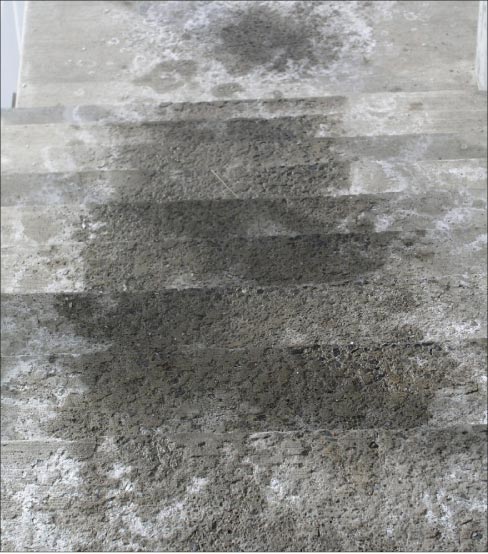The Stone Detective: The Case of the Winter Blues
Frederick M. Hueston, PhD
It was a beautiful but chilly Sunday, and I was spending the afternoon inside doing the weekly crossword puzzle. Yes, I must be getting old if I’m doing these puzzles. I came across a one-word clue: “Salt.” Now, most people would immediately think of table salt, but not this stone detective. I have the curse of being in the stone business, and little did I know that this one-word clue would lead me to my next case.
Just as I was about to get out the crossword dictionary, my cell phone rang. As it was Sunday, so I thought it was a friend or relative calling, but NOOOOOOOO. The voice on the other end sounded desperate. In a gravely voice he said he was the chief engineer at a major university, and their terrazzo, marble foyers and concrete lobbies were falling apart, and he didn’t know what was happening. He did apologize for calling me on a Sunday, but he continued to tell me that all their buildings have this problem. He asked if I could come and perform an inspection.
To put things into perspective, this morning it was 36 degrees here in Florida, and he was in upstate New York where they had a couple of inches of snow and temperatures down in the single digits. I wasn’t looking forward to a trip in the very, very cold North this time of year. Last time I did an inspection I ended up with a cold. But, money is money, so I agreed to do the inspection.
I booked a flight to the frigid North and kept my fingers crossed that my flight wouldn’t be canceled. I could write a book on the numerous times my flights have been delayed and canceled… but that’s another story. Luckily, this time my flight took off on time and landed in a middle of a snowstorm. Well, I thought, at least it landed. I got off the plane and ran over to the rental car counter, hoping they had something in a four-wheel drive. Fortunately, they did have a small, four-wheel drive SUV.
“It’s not my Woody, but it will do,” I told the puzzled clerk.
It took me three hours to drive 15 miles to the campus. The roads were snow-covered, and cars and trucks were sliding all over the place. Just as I was about to pull into the campus, a large deer leaped across the road in front of my car. It was a near miss, and I slid a bit, but I was able to recover and not end up in a ditch. (I grew up in the North and was glad to discover I hadn’t entirely lost my winter driving skills!)
 |
|
A classic example of spalling due to absorbed salts – in this case, de-icing salts are the culprit – but now there’s a solution and a cure. |
I saw I’d have to plow my way through snowdrifts to the building where I had arranged to meet my contact. I got out of the car and within seconds fell on the ice. First, I wondered if anyone had seen me, and second, I wondered if I ought to raise my fee for hazard pay. The only thing hurt was my pride, since several college students were actually standing nearby, pointing at me and laughing. In my day we would have run over to make sure the old geezer who had fallen was OK. Anyway, I brushed myself off and walked very slowly and carefully to the front entrance. Just as I was about to open the door, a maintenance worker came by and was spreading deicing salt on the sidewalk. I stopped and introduced myself and asked if could find out what kind of salt he was using. He showed me the bag of salt, and I knew right away what the problem was before I even inspected the damage (see photo).
I walked inside and found my contact right away. I looked at him, and of course, the floor. I took out my trusty moisture meter, some filter paper and some distilled water and placed it on the floor. This is a little test I use to test for salts. If the moisture reading is higher than just plain distilled water, that indicates salts are present. (By the way, I teach this technique in my stone and inspection class.) It is not only good for detecting deicing salts, but also works well for efflorescence issues.
I finished my test and looked up at my contact and told him that the salts they were using for de-icing were causing the deterioration. I explained that the salts dissolve and enter the pores of the stone and concrete, and when they dry, they crystallize, causing pressure in the pores. The salts are larger than the pores, and that is what causes the spalling.
I told him he could do several things. First, I would recommend he change the type of salts. There are many salts now on the market that don’t cause this problem. I also told him he could just not apply the salts and hire a good law firm for fight all the slip-fall lawsuits (No, I really didn’t tell him that.). He asked me if the spalling could be fixed. I told him that the spalls could be filled, but the all the floors would have to be rinsed and treated to remove the salts to prevent further damage.
Another case solved. Now, where is the nearest Starbucks– I’m freezing!
The Stone Detective is a fictional character created by Dr. Frederick M. Hueston, PhD, written to be entertaining and educational. Dr. Fred has written over 33 books on stone and tile installations, fabrication and restoration and also serves as an expert for many legal cases across the world. Send your email comments to him at fhueston@stone forensics.com.